Killarney Provincial Park Observatory
The Killarney Provincial Park Observatory is an astronomical observatory located at the George Lake Campground of Killarney Provincial Park (a 420 km drive north of Toronto or a 100 km drive southwest of Sudbury). The Observatory is operated by Ontario Parks and houses two observatory buildings. The original facility contains a 10" telescope with solar filter, ideal for nighttime as well as daytime viewing of the Sun. The newer facility (built in 2018) contains a 16" fully automated telescope with a 5" refractor and is ideal for research, astrophotography and public use. Both telescopes are available for Discovery programs (formally known as Natural Heritage Education (NHE) programs) as well as private sign-out (self-use) by interested visitors.
 | |
| Organization | Killarney Provincial Park |
|---|---|
| Location | Killarney Provincial Park, Sudbury District, Ontario, Canada |
| Coordinates | 46°00′45″N 81°23′58″W |
| Altitude | 266 m (873 ft) |
| Telescopes | telescope |
 Location of Killarney Provincial Park Observatory | |
Astronomy in Killarney Provincial Park
Astronomy education began in the Park in 1985 as part of outreach programs provided by Bruce Waters on behalf of the McLaughlin Planetarium. Interest in the astronomy programs quickly grew with these Discovery Programs (formally Natural Heritage Education (NHE) programs) seeing some of the highest attendance levels (exceeding 200 people per night). In time, other astronomy educators such as Bill Gardner, Bill and Vicki Sherwood and staff from Science North, began providing programs of their own.
Astronomy education continues to this day and has included Western as well as Indigenous (Anishinaabek) constellation learning, comet making workshops and music as a way to bring the mysteries of the stars to the visitors of Killarney Provincial Park.
History of the Observatory Complex
Waasa Debaabing (smaller observatory housing a 10" Telescope)

In 2010, to celebrate 25 consecutive years of astronomy education provided by Bruce Waters, it was decided to establish a permanent facility (observatory building and telescope system) that could meet the following requirements. To be available for:
- year-round use
- the NHE staff to provide programing of their own (rather than solely relying upon astronomy educators)
- self-use such that any person with interest could sign out the facility for themselves
A 10" Meade 2120 LX3 on a fork mount within a SkyShed POD system was opened to the public on July 17, 2010.[1][2] At the time, the observatory was the first public use observatory in any provincial park.[3] This setup provided excellent views but limited automation. In 2011 the telescope mount was upgraded to a Losmandy G11 Gemini 2 automated system. This upgrade significantly improved the usability of the telescope for staff and Park visitors alike. The observatory sits upon a deck with two ramps (to ease the movement of people) donated by the Friends of Killarney Park.
Anishinaabemowin Naming
On September 28, 2019 at the Stars over Killarney event, the Observatory was given its official name - Waasa Debaabing (WAH-suh De-BAH-bing) which, in Anishinaabemowin means,"seeing far (as the eye can see)" or "the far in the distance seeing". The name was given in honour of the Indigenous astronomy theme of the 2019 Stars over Killarney event.
To hear the name in Anishinaabemowin, please click here.
Kchi Waasa Debaabing (larger observatory housing 16" and 5" Telescopes)
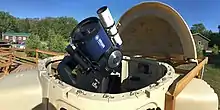
After eight years of use, it became apparent that there were ways to optimize the facility and, in 2017, an upgrade initiative kicked off to provide a second observatory dome and equipment that would meet six key requirements:
- spectacular visual capability
- optimized for both wide-field and high magnification astrophotography
- high usability for both the Discovery program staff as well as self use
- increase of available space within the observatory to suit public programming
- low maintenance for Park staff (protection from moisture, bugs, pollen, etc.)
- highly resistant to accidental damage
A decision matrix was established and vetted against real world feedback from existing users who were kind enough to donate their time and expertise, most notably:
- Hyde Memorial Observatory (Lee Thomas and Rick Johnson),
- Z-Field Observatory (Kevin Cobble),
- Lethbridge Astronomy Society (Dwight Jones, Telescope Coordinator), and
- Paul Titus, Amateur Astronomer and former President of Roper Mountain Astronomers of Greenville, SC
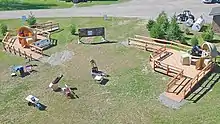
Based on the requirements and usage data available, it was decided that a closed tube telescope of large aperture plus an apochromatic refractor mounted on a permanent equatorial pier would suit all the requirements listed above.
In 2018, the new Observatory was opened and houses a Meade LX600-ACF 16" f/8 (ideal for planets and deep sky astrophotography) with a Meade Series 6000 130mm ED APO refractor mounted on top for lower magnification / wide field use. The entire assembly sits on a cast steel Permanent Equatorial Pier to ensure overall stability and consistency of the equipment. This dome utilizes a SkyShed GPOD with a two-door observatory structure and features a "slide-off" roof assembly to provide more headroom. The observatory sits upon a deck with two ramps (to ease the movement of people) donated by the Friends of Killarney Park.
First Light of the 16" Telescope
The second Observatory (housing the 16" and 5" telescopes) was completed in June 2018. First light for the new system was on the weekend of June 9, 2018 with spectacular "space-walk" views of the Globular Star Clusters M13, M11, M22, M3, M80, as well as the Nebulae M8 and M20. Attendees celebrating the opening included astronomers in residence, park Interpreters from the Discovery team and representation from Science North's Space Place.
Anishinaabemowin Naming
On September 28, 2019 at the Stars over Killarney event, the Observatory was given its official name - Kchi Waasa Debaabing (g-CHEH WAH-suh De-BAH-bing) which, in Anishinaabemowin means,"seeing very far (as far the eye can see)" or "the very far in the distance seeing". The name was given in honour of the Indigenous astronomy theme of the 2019 Stars over Killarney event.
To hear the name in Anishinaabemowin, please click here
Astronomy Programs
Dark-sky preserve

Killarney Provincial Park has been designated as a Wilderness Class Provincial Park within Ontario. As such, its development plan includes significant provisions to protect all of the pristine wilderness that it governs. In keeping with this special designation, significant attention has been spent to ensure that lighting controls fall within the best practices of the Royal Astronomical Society of Canada. On February 28, 2018, Killarney Provincial Park joined the list of prestigious locations designated as a Dark-Sky Preserve by the Royal Astronomical Society of Canada. In keeping with the requirements of the Dark-Sky Preserve designation, the Park provides education on proper lighting use and controls as part of its regular programming.[4]
Self Use Sign-out
While the Observatory is used for special large audience presentations (with upwards of 200 people) and by the Discovery Team interpreters, the real beauty of the facility is that it has been optimized for self-use. This program, currently available from July through September, allows anyone visiting the park free access to a research level observatory that only requires the most basic of training (provided in advance by the Park staff). In this regard, the Killarney Provincial Park Observatory was North America's first free, public, self-use facility in North America.[5]
Astronomer in Residence program
Established in 2012, the Killarney Provincial Park "Astronomer in Residence" program sees experienced guest astronomers providing their services to the park on a daily basis. These resident astronomers provide a variety of educational services in support of the NHE programs. Such services include: daily observatory training, solar observing, night sky observing and other programs that encompass a wide variety of information that is related to both astronomy and its relationship to the Killarney Provincial Park experience
Meteorite Display
In addition to the programs available in the Park, visitors can enjoy looking at a small meteorite collection available inside the Park office during regular visiting hours. Included are an iron meteorite fragment, an etched slice of meteorite displaying Widmanstätten patterns and a very rare Allende (pronounced Ah-Yen-Day) meteorite that contains pre-solar grains.
Astrophotography
The light gathering ability of a 16" telescope coupled with Meade's "Advanced Coma-Free" design in a Dark-Sky Preserve provides exceptional astrophotographic capability. On July 9, the telescope was aligned to better enable long duration astrophotography. Using today's stacking technology and cooled CCD cameras will yield outstanding results. Initial DSLR photography was obtained to demonstrate the capability of single image, "thumb-on-the-shutter" exposures. All the images (below), with the exception of Mars, were taken with the primary (16") or secondary (130mm) telescopes.
 Mars taken with the 16" telescope in the Kchi Waasa Debaabing Obsevatory at the Killarney Provincial Park Observatory |  M31, the Andromeda Galaxy taken through the Killarney Provincial Park Observatory - Dome 1, Secondary Telescope | 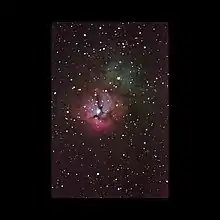 M20, the Trifid Nebula taken through the Killarney Provincial Park Observatory - Dome 1, Primary Telescope | 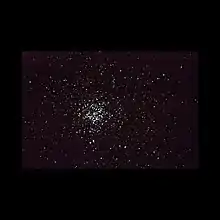 M11, the Wild Duck Open Cluster taken through the Killarney Provincial Park Observatory - Dome 1, Primary Telescope | 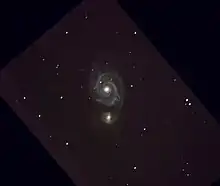 M51, the Whirlpool Galaxy taken through the Killarney Provincial Park Observatory - Dome 1, Primary Telescope |
The 16" Telescope Observatory & SkyShed POD Setup
Observatory modifications
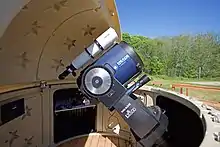
The Skyshed POD system is normally designed to house a Telescope of maximum 14" in size.[6] However, with the careful placement of the permanent equatorial pier inside the southernmost storage POD bay, the 16" plus refractor were all shifted southwards allowing the height necessary to accommodate the entire system.
In addition, by using a Fork Mount and not a German equatorial mount with its heavy and extended counterweight, more space was provided within the observatory structure itself.
Concrete and cast steel pier alignment
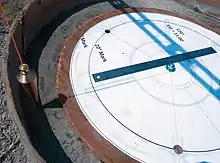
To support the weight of the telescope system (over 500 lbs) and to ensure that the system was set up for long term maintenance-free use, it was decided to set everything atop a rigid, fixed equatorial mount. The Meade Permanent Equatorial pier was chosen and custom cast to the latitude of Killarney Provincial Park. In addition, its height was reduced by 12" so that it could better fit within the observatory dome and eliminate the necessity of using a step ladder.
Construction and alignment of the concrete mount alignment
Because the location is subject to significant frost heaving, 6000 pounds of concrete were poured to a depth of 6' deep to form a foundation and 36" diameter solid concrete pier. Once the concrete had set, it was time to worry about preparation for the alignment of the cast steel pier. Meade provides the cast steel pier mount with approximately 5 degrees of play so a very accurate alignment onto the concrete base would be required to ensure that the necessary tolerances would accommodate the play provided. Using a compass is tricky and often inaccurate due to the rebar within the concrete pier interfering with the compass' magnetic reading. So another solution was required.
Thousands of years ago, many cultures used the plumb bob to find proper alignment and it was decided to use this technique to obtain perfect alignment. Two readings were taken separated by two hours to obtain a very accurate triangulated result. Exact positions of the sun for the Observatory location were taken from a smartphone using an astronomy application. A one lb wooden jig (substituting for the 250 lb steel mount) was pivoted so that the shadow from the plumb bob fell exactly along one of the pre-drawn lines. Once the alignment process was completed with the jig, guide holes were drilled into the concrete base before the actual steel pier was fitted atop. Once it was confirmed that the guide holes were properly aligned to the steel pier, three 12" threaded rods were epoxied into fully drilled holes and allowed to set over night.
Selected books
In 2011, a unique guide book was published in which all of the proceeds are to be directed towards supporting the Observatory as well as other Friends of Killarney Park activities. "A Camper's Guide to the Universe", has useful stories, anecdotes and much information derived from Bruce Waters' astronomy talks in the park. This book is geared towards campers and lay folk who are interested in an introductory field guide to the skies.
External links
References
- http://www.ontarioparks.com/parksblog/star-gazing-observatory-at-killarney-provincial-park/
- https://www.rasc.ca/sites/default/files/publications/Bulletin-2010-09.pdf
- http://www.ontarioparks.com/parksblog/astronomy-in-the-park/
- https://www.rasc.ca/dark-sky-site-designations
- http://www.ontarioparks.com/parksblog/see-the-stars-at-killarneys-observatory
- http://www.skyshedpod.com